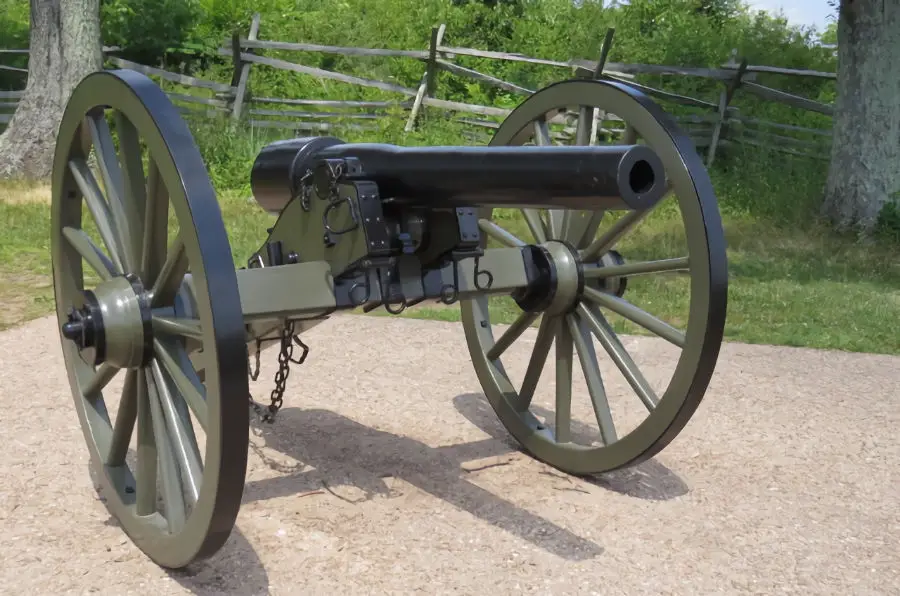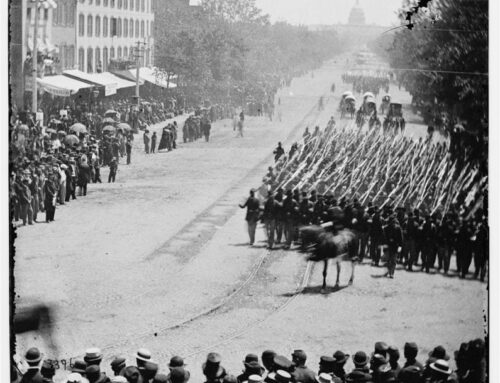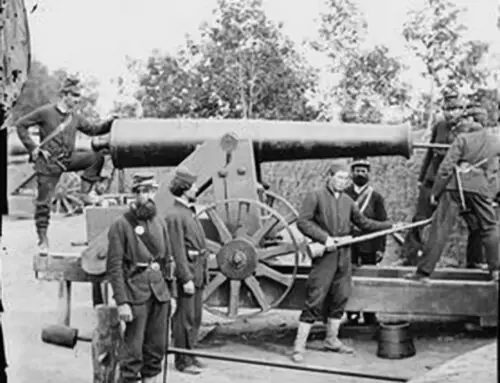The Civil War Parrott Rifle was a groundbreaking artillery innovation that significantly influenced the tactics and outcomes of the American Civil War. Renowned for its enhanced accuracy and extended range, this rifled cannon transformed battlefield engagements and siege warfare.

A 10-Pounder Parrott Rifle at Gettysburg, PA
The Inception of the Parrott Rifle
The Civil War Parrott Rifle emerged from the innovative mind of Robert Parker Parrott, a West Point graduate and former U.S. Army officer. After resigning from the military, Parrott became the superintendent of the West Point Foundry in 1836. His exposure to artillery manufacturing and engineering expertise led him to address the limitations of existing cannon designs.
In 1860, Parrott patented his rifled cannon design, which ingeniously combined affordability with advanced technology. His invention arrived at a crucial moment, just before the outbreak of the Civil War, positioning the Parrott Rifle as a significant asset in the impending conflict.
Design and Technological Advancements
The Parrott Rifle was distinguished by several key innovations that set it apart from traditional Civil War artillery.
Rifled Barrel Innovation
The introduction of rifling—a series of spiral grooves inside the barrel—allowed the Parrott Rifle to impart a stabilizing spin to its projectiles. This spin greatly enhanced accuracy and range compared to smoothbore cannons, enabling gunners to hit targets with unprecedented precision.
Reinforced Breech Mechanism
Parrott addressed the issue of barrel strength by reinforcing the breech—the rear part of the cannon where the explosion occurs—with a wrought iron band. This reinforcement allowed the cannon to withstand higher internal pressures, reducing the risk of catastrophic failures that were common with cast iron cannons of the era.
Specialized Projectiles
Parrott designed projectiles specifically for his rifle. These shells featured expanding brass rings or sabots that engaged the rifling grooves upon firing. This engagement ensured a tight seal (known as obturation), maximizing the propellant’s force and improving both range and accuracy.

A 10-Pounder Parrott Rifle, Gettysburg, PA
Production and Variants
Different Calibers and Models
The Parrott Rifle was produced in various sizes, ranging from the light 10-pounder models to the massive 300-pounder siege guns. The “pounder” designation referred to the weight of the projectile the gun fired.
- 10-Pounder Parrott Rifle: Widely used in field artillery, it balanced mobility with firepower.
- 20-Pounder Parrott Rifle: Offered greater range and destructive capability, suitable for both field and siege operations.
- 30-Pounder and Above: Primarily used in siege operations and coastal defenses, these larger models delivered devastating blows to enemy fortifications.
Manufacturing Challenges
While the design was advanced, producing Parrott Rifles presented challenges. The combination of cast and wrought iron required precise manufacturing techniques. Despite these difficulties, the West Point Foundry and other facilities managed to produce hundreds of these cannons during the war, showcasing the industrial prowess of the Union.
Deployment in the Civil War
Union Arsenal and Strategies
The Union Army incorporated the Parrott Rifle extensively into their artillery units. Its long-range capabilities made it ideal for:
- Siege Operations: Bombarding fortified positions from a safe distance, reducing casualties.
- Defensive Emplacements: Protecting strategic locations with overlapping fields of fire.
- Naval Warfare: Mounted on ships for coastal bombardments and blockades, enhancing naval firepower.
Confederate Utilization and Limitations
The Confederacy, lacking the industrial capacity of the North, faced challenges in producing Parrott Rifles. They relied on:
- Captured Cannons: Utilizing Parrott Rifles seized during battles, though supply was inconsistent.
- Limited Manufacturing: Southern foundries produced a small number of similar rifled cannons, but resource scarcity hindered large-scale production.
- Alternative Designs: Resorting to other artillery types when Parrott Rifles were unavailable, often with less effectiveness.
Notable Battles Involving the Parrott Rifle
Battle of Fort Pulaski (April 1862)
This battle marked a significant demonstration of the Parrott Rifle’s effectiveness. Union forces set up batteries equipped with Parrott Rifles on Tybee Island, bombarding Fort Pulaski from over a mile away. The rifled artillery breached the fort’s walls in just 30 hours, leading to a Confederate surrender. The battle underscored the obsolescence of traditional masonry fortifications against rifled artillery and showcased the strategic value of the Civil War Parrott Rifle.
Siege of Vicksburg (May-July 1863)
During the protracted Siege of Vicksburg, Union artillery, including numerous Parrott Rifles, continuously bombarded Confederate defenses. The ability to shell the city from afar weakened Confederate morale and defenses, contributing significantly to the Union’s eventual victory and control over the Mississippi River—a turning point in the war.
Battle of Gettysburg (July 1863)
Parrott Rifles were part of the extensive artillery duels during the Battle of Gettysburg. On the second day, Union artillery positions on Cemetery Hill utilized Parrott Rifles to repel Confederate assaults, providing critical support to infantry units. Their accuracy and range were instrumental in maintaining defensive lines.
Advantages and Limitations
Tactical Benefits
- Enhanced Accuracy: Allowed precise targeting of enemy positions, fortifications, and artillery, reducing ammunition waste.
- Extended Range: Could engage targets beyond the reach of enemy smoothbore cannons, offering a strategic advantage.
- Psychological Impact: The Parrott Rifle’s destructive capability had a demoralizing effect on enemy troops, potentially impacting their effectiveness.
Operational Drawbacks
- Durability Concerns: The cast iron construction, despite reinforcement, was prone to cracking and bursting after sustained use, posing risks to the crew.
- Logistical Issues: Larger models were heavy and difficult to maneuver, requiring substantial transportation resources and limiting rapid deployment.
- Safety Risks: The potential for barrel explosions necessitated cautious operation and frequent inspections.
Impact on Military Strategy
Shift in Siege Warfare
The effectiveness of the Parrott Rifle against fortifications led to a reevaluation of military engineering. Traditional forts with thick masonry walls were no longer impregnable, prompting a shift towards:
- Earthen Fortifications: These could absorb artillery impacts more effectively than masonry.
- Redesign of Defensive Structures: Incorporating angles and reinforced positions to mitigate the effects of rifled artillery.
Influence on Fortifications
Military architects began designing fortifications with:
- Lower Profiles: Reducing visibility and targetability.
- Dispersed Structures: Spreading out defensive positions to minimize damage from concentrated artillery fire.
- Improved Materials: Using sandbags, timber, and earth to reinforce defenses.
The Parrott Rifle’s Legacy
Post-War Usage
After the Civil War, the Parrott Rifle saw limited use as newer technologies emerged, such as:
- Steel Breech-Loading Cannons: Offering greater durability and faster firing rates.
- Advancements in Ammunition: Development of more effective shells reduced reliance on specific artillery types.
However, surplus Parrott Rifles were used in coastal defenses and as training equipment well into the late 19th century, reflecting their continued utility.
Influence on Modern Artillery
The principles demonstrated by the Parrott Rifle influenced future artillery designs:
- Rifling Standardization: Rifled barrels became the norm, greatly enhancing the effectiveness of artillery worldwide.
- Material Innovations: Transition to steel construction improved durability and safety.
- Breech-Loading Mechanisms: Improved loading times and operational efficiency, building upon the quest for better artillery initiated by the Parrott Rifle’s innovations.
Conclusion
The Civil War Parrott Rifle was a technological marvel of its time, embodying the intersection of industrial innovation and military necessity. Its contributions to the Union’s artillery superiority were significant, altering the course of numerous battles. Beyond its immediate impact, the Parrott Rifle spurred advancements in military technology and strategy, leaving an indelible mark on the evolution of warfare.
By understanding the Civil War Parrott Rifle, we gain insight into how technological advancements can redefine combat and influence the broader scope of history. Its legacy serves as a testament to the rapid pace of innovation during times of conflict and the enduring quest for military superiority.


